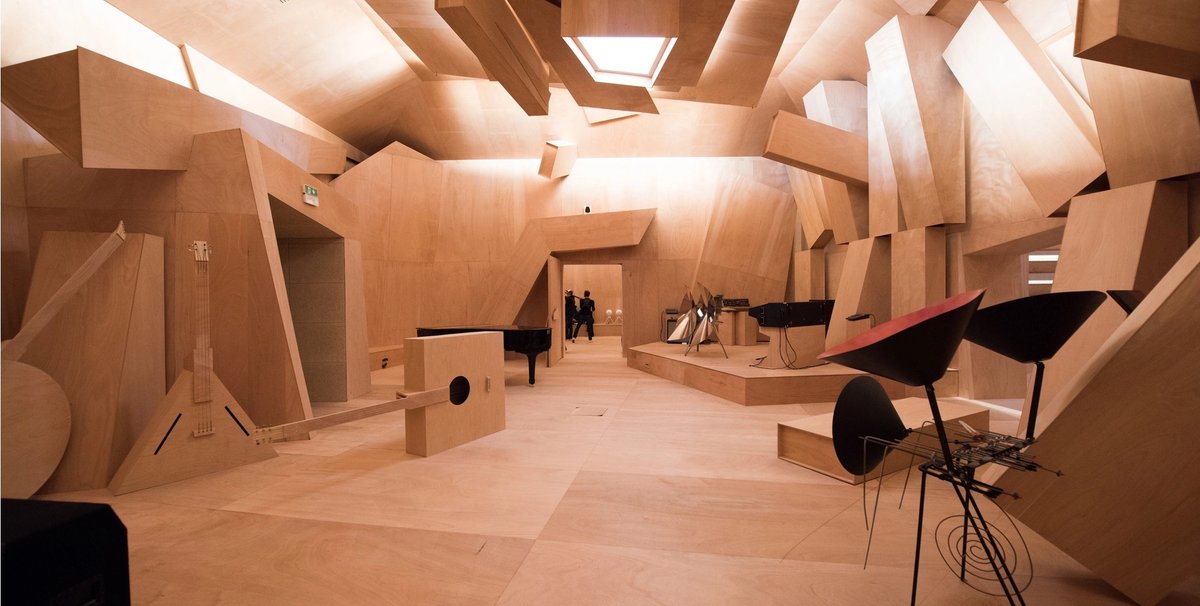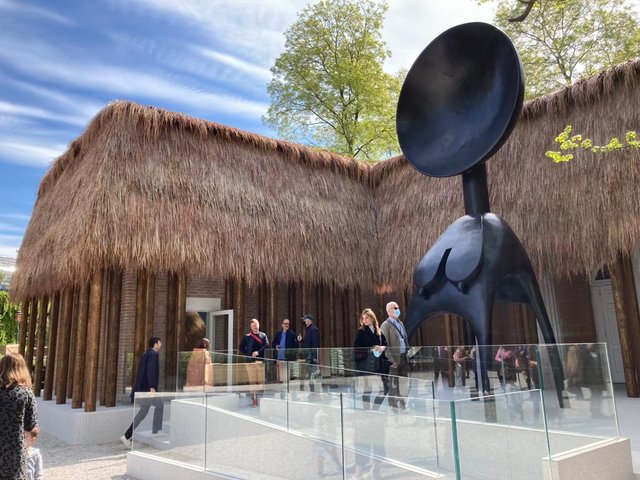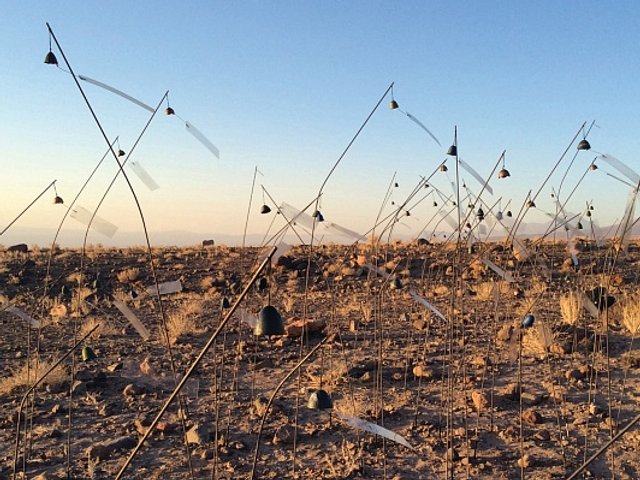The Venice Biennale opens to the public this weekend (13 May-26 November), but the 57th edition includes so many sound works and sculptures it feels as though the city’s Biennale of Music later in the year (29 September–8 October) has been given a head start—as invited guests discovered this week. Visitors to the French pavilion encounter professional musicians and sound technicians rather than paintings and sculptures as the artist Xavier Veilhan’s Studio Venezia has turned the space into a working recording studio.
The pavilion is fitted with obscure electronic instruments such as the ondes martenot and other equipment lent by (among others) Nigel Godrich, the Radiohead producer. The plywood grotto design draws inspiration from Kurt Schwitters’s lost Merzbau, which Veilhan calls a “benchmark” in installation art. According to the Biennale catalogue: “The artist, present during the seven months of La Biennale, hopes the pavilion becomes a living, breathing space rather than a passive receptacle for predetermined programmes.”
Samson Young, who is representing Hong Kong, has created Songs for Disaster Relief, complete with an outdoor stage area, gold discs and chill-out zone. He riffs on charity singles of the 1980s and 90s, such as USA for Africa’s 1985 charity anthem in We Are the World, as performed by the Hong Kong Federation of Trade Unions Choir (2017). Young is a trained musician, and his ongoing research into sound, supported by the BMW Art Journey Award, has focused on bell ringing, including at St Paul’s Cathedral in London, he told us.
The Chinese pavilion offers a group show of artists with a shared interest in shadow-play puppet theatre. It includes traditional musicians, many of them elderly, who can be seen wandering in the garden of the Arsenale between performances.
Carlos Amorales’s installation in the Mexican pavilion, also in the Arsenale, is regularly animated by musicians playing the shard-like pottery pipes, or octarines, like those the artist has created for Life in the Folds.
Cevdet Erek fills the Turkish pavilion with an exhibition titled ÇIN, an onomatopoeic Turkish word for a metallic bell sound and also the effect of tinnitus. It’s one noisy experience.
Also in the Arsenale, this time outside the former naval complex buildings, an audio and highly tactile sculpture by the Polish artist Alicja Kwade is proving irresistible to Biennale visitors. Monumental spheres of polished stones of variable dimensions and different colours resemble a cluster of planets, arranged as if they were billiard balls rather than in any orbit around the sun. Called Pars pro Toto (2017), Kwade’s special project was commissioned by the curator of the main show, Christine Macel. It includes sounds—sometimes gentle, sometimes dramatic—that seem to come from the constellation of stone.
The French-born artist Kader Attia turns to Arab golden age singers from his childhood for his Narrative Vibrations piece in Viva Arte Viva. The work is a comment on a lesser known aspect of postcolonial popular culture. It comprises a multichannel installation showing vintage concert recordings of female superstars, such as the Algerian singers Reinette l’Oranaise and Meriem Fekkai. The rise and fall of their voices causes couscous placed on connecting circular trays to jump and vibrate (the electromagnetic waves in the songs make the grains move).
Macel, the chief curator of the Centre Pompidou, has also included the 96-year-old US choreographer Anna Halprin’s Planetary Dance (1961-2017). Videos of annual performances of the group-healing ritual in locations ranging from San Francisco to Marseille will be screened in the Arsenale, and live performances of the happy-clappy event will also take place.
Macel has often worked in the past with artists who use sound and music as a medium. She organised the French pavilion in the 2013 Venice Biennale, when the artist Anri Sala combined two pieces of music by Ravel. For Viva Arte Viva’s Pavilion of Traditions, Sala has created a large-scale wall work, All of a Tremble (Encounter 1), combining two designs for printed wallpaper and the patterns’ roller, which he has converted into a novel musical instrument. The patterns are “played” as the steel combs are plucked, like a giant musical box, creating a surprisingly harmonious piece.
Percussive sound, of a loud, clashing, rock music sort, stops visitors in their tracks at the very start of Viva Arte Viva in the Giardini’s Central pavilion, when the US artist Dawn Kasper feels in the mood. Under an ornate dome, a garage band studio seems to have popped up, where Kasper performs on an array of instruments. Her work The Sun, The Moon, and the Stars (2017) is part of her Nomadic Studio Project, which she has moved to Venice for the duration of Macel’s main show. This means the first Pavilion of Artists and Books is rarely a hushed, library or traditional museum-like space. More of Kasper’s favourite music, live and recorded, is guaranteed.




